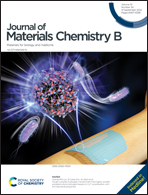Rapid synthesis of drug-encapsulated films by evaporation-induced self-assembly for highly-controlled drug release from biomaterial surfaces
Abstract
Infection at the surgical site for dental implants results in failed procedures, patient pain, burdensome economic impact, and the over-prescription of prophylactic antibiotics. Mesoporous silica films as coatings for implants may provide an ideal antimicrobial drug storage and local release vector to the site of infection, however traditional drug loading techniques result in insufficient drug load and short-term release kinetics. In this work, we have applied a method to use a surfactant-antimicrobial drug octenidine dihydrochloride (OCT) as a template for mesostructured silica, to demonstrate silica–OCT composite films. The films are synthesized by evaporation induced self-assembly (EISA) and we explore the effects of synthesis parameters on porous film structure, OCT incorporation, and OCT drug release rates. Drug micelle incorporation into the silica mesostructure was highly dependent on silica precursor pre-reaction to form silica oligomers before film spin-casting. The OCT drug concentration of the synthesis solution dictated the time required for effective incorporation (without phase separation), with total loading in the film of up to 90% by mass. The OCT content in the films was found to directly determine the timescale of drug release, from 2 to 8 h for a single layer film. The total release timescale was increased by the addition of multiple layers of OCT–silica films to nearly 2 weeks. Drug release from films completely inhibited Streptococcus mutans (UA159) growth, while drug-free porous silica films showed no increase in bacterial growth over non-porous control. These OCT–silica films have a significant potential to store and release antimicrobial drugs from dental implant surfaces.



 Please wait while we load your content...
Please wait while we load your content...